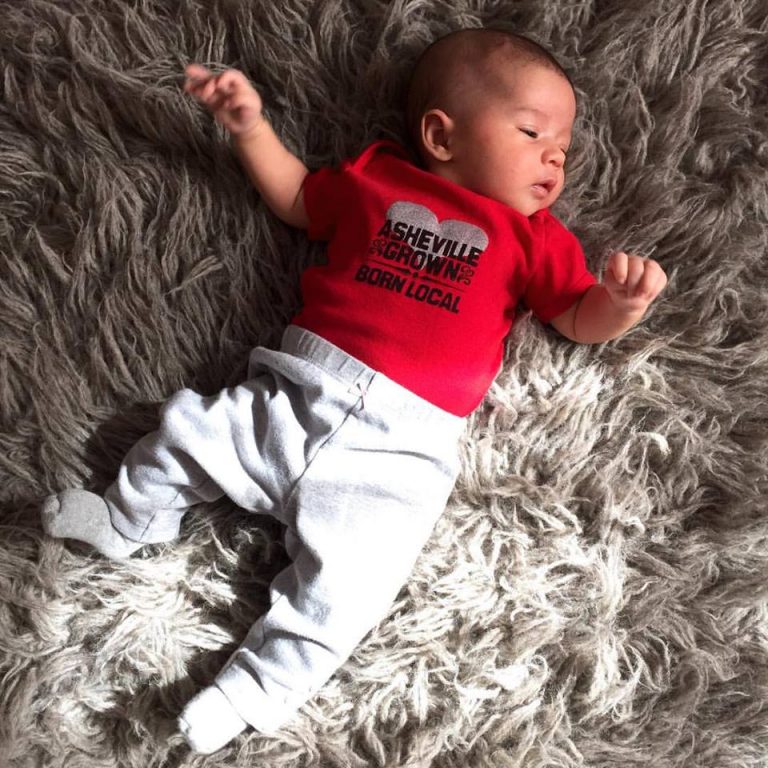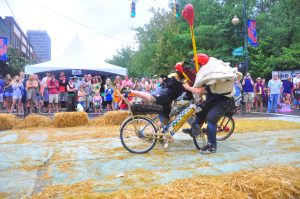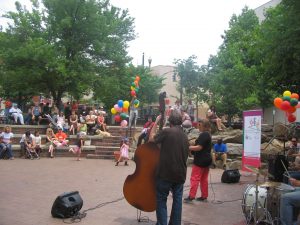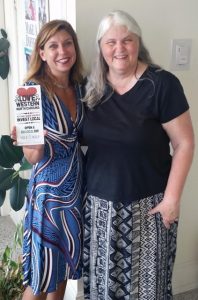
Julian Price planted seeds of inspiration that others now cultivate and continue to sow into the future. The restaurants he helped sponsor have now spawned other ventures. Real estate developers he worked with continue to think about how their work can create employment and city vibrancy. Pat Whalen and Joe Minicozzi, through Public Interest Projects and its offspring, Urban 3, have taken the story of Asheville’s resurgence on the road, providing a downtown revitalization template for cities around the country. Kitty Love, executive director of the Asheville Area Arts Council, works to link art projects to each member of the community, recognizing the importance of beauty and vision for a thriving downtown. Mary Ann West and Downtown Asheville Residential Neighbors care for Pritchard Park, echoing Price’s understanding that natural beauty is an essential part of urban settings. Franzi Charen, founder of Asheville Grown Business Alliance, seems to channel Price as she works to help local businesses and entrepreneurs thrive. She knows, as Price did, that local entities’ success lends Asheville the quirky individuality that locals love and that draws 10 million visitors a year. Price helped others see Asheville as he did and inspired his generation and the next to dig in and create an environmentally healthy place where anyone can play a part.
Ripples of Inspiration
Julian Price never expected to change Asheville single-handedly. He wanted to help smart, creative entrepreneurs and organizations that were also dedicated to making Asheville a just and beautiful place to live. His work planted the seeds for Asheville’s resurgence. And the people who continue to help Asheville seem to hear Price whispering his encouragements in their ears.
They are people like the restauranteurs who PIP (Public Interest Projects) encouraged and supported who have continued to create neighborhood spots. Joan and Joe Eckert of The Laughing Seed went on to found Jack of the Wood and Green Man Brewery. And Joe created City Bakery so he could serve bread at Jack of the Wood.
The Brewery, founded in 1997 and now owned by others, has in 2016 opened a $5 million expansion that includes a specialty brew house, a retail shop, and a taproom loft. Its sour ale, Bootsy, won the 2015 Best in Show at the Carolina Championship of Beer–and seven other Green Man brews won awards as well. City Bakery, opened in 1999 (and now owned by others), has won the Best of WNC Award by Mountain Xpress from 2007-2014 for Best Bread, Best Bakery, and Best Breakfast Restaurant.
And no Ashevillian is unaware of Salsa’s, its burritos as big as a lineman’s bicep.*** Price and PIP helped fund its owner Hector Diaz to expand Salsa’s (now in the Mountain Xpress Hall of Fame) and to open Zambra’s. Since then, Diaz has created Chorizo and Modesto Trattoria, both in the Grove Arcade Building, their plates as sumptuous and creative as Salsa’s. (Think wood-fired octopus or house-made chorizo and plantains.)
Zambra’s current owners, Peter Slamp and chef Adam Bannasch (PIP continues to own a share), have also spawned offspring, wanting new neighborhood spots that create a sense of community. Slamp opened King James Public House (now closed) on Charlotte Street in January 2012 (Winner of the 2015 Asheville Wing Wars for Specialty Wings). And in October 2015, Bannasch and his wife opened Copper Crown, a New Orleans-influenced bistro in East Asheville. Former Zambra chef Josh Dillard and three partners have set up shop in their new restaurant and brewery, Bhramari Brewhouse, behind the Orange Peel.
Real estate investors who knew or worked with Price also in some ways continue either his work or philosophy. Tom Leslie was a consultant for PIP during the restoration of the first building they bought, the Carolina Apartments. President and owner of the property management firm Leslie and Associates, Inc., Leslie admits he had doubts that Price and Whalen could lease apartments that had no parking. But, he says, the 27 units have been full for the past 22 years. Leslie, who worked with the pair on other buildings, continues to keep those occupied and maintained, saying, “We’re providing downtown residential housing, which was one of Julian’s primary goals.”
Asheville real estate investor Jerry Sternberg initially thought Price was a bizarre outsider. “He looked like a field hippie with long hair and faded jeans. And we’d listen to him and the things he was dreaming about and think he was crazy as hell.” But over breakfasts at the Battery Park Hotel and occasional golf games, Price soon won Sternberg’s respect. “We both loved and cared about Asheville and found we had a tremendous amount in common about how Asheville should be shaped and what we should be doing with it.”
Now, Sternberg, in his own work leasing warehouses and industrial buildings, feels that he shares Price’s idea that people here need decent jobs and housing: “One thing I’ve striven to do is find tenants who provide good jobs. I do try to steer it that way and that’s a contribution.” As for the bizarre Price, Sternberg has only praise: “There’s no question he was the unselfish catalyst for bringing around the turnaround of Asheville.”
That turnaround is not just Price’s story but the story of many others like talented chefs, entrepreneurs, real estate investors, and artists who continue–either directly or indirectly–Price’s energy and success. Below are just a few narratives about those who, knowingly or not, honor Price– and Asheville–with their work.
Partners for the Public Interest
In 1990, Julian Price chose Pat Whalen first as his lawyer and next as his partner in founding Public Interest Projects, the for-profit development company that has funded numerous projects central to Asheville’s downtown comeback. During Price’s 11 years in Asheville and since his death, Whalen has meticulously enacted Price’s–and his own– vision of downtown.
Whalen has done that in part by sharing with other cities the business model and systems that he and Price created, a notion that was part of PIP’s mission from the outset, says Whalen. As cities saw and heard about Asheville’s reformation, they began to contact PIP. “We were getting attention even before stories appeared in the national press about Asheville’s revitalized downtown,” says Whalen. “That led other cities’ leaders to contact us and ask how did you do that?” To tell Asheville’s story, Whalen has traveled to myriad cities–from Lancaster, Pennsylvania, to Flint, Michigan, to Panama City, Florida.
“I really believe more and more in what we are doing, that cities and urban places are tremendous sources of strength for the economy, for human interaction, for creativity and progress, and for the environment,” says Whalen. “What we started teaching is that density–making urban places attractive so communities have the desire to put in housing and interesting businesses in their central areas and town centers–is a big antidote to sprawling growth.”

Planner Joe Minicozzi, AICP, founder and principal of Urban3, a consulting company, knows firsthand that PIP’s model can be duplicated: “But what Pat is being modest about is that not everyone is a Pat Whalen. His attitude is if you work hard enough and apply your smarts, you can run through any wall. But you have to have people who won’t take “no” for an answer. You have to have the right people like Julian and Pat to get it done.”
The PIP model is an arduous, hands-on one, agrees Whalen: “What we did was really by working, working, working with whomever we invested in.” That’s the work ethic–plus thoughtful investment–that rewrote Asheville’s future.
Public Interest Projects has invested more than $15 million in downtown Asheville. As early as 1994, PIP began to garner awards from the Preservation Society of Asheville and Buncombe County (1994, ‘95, ‘98, 2002, 2004); the International Downtown Association (‘99); the International Making Cities Livable Council (2000); Smart Growth Partners of Western North Carolina (2001); and the Historic Preservation Foundation of North Carolina (2002).
“I think what Julian would be proudest of is what he enabled this community to accomplish,” says Whalen. “It’s a miracle [what Asheville’s become] since 1990.”
Density Economics
In the early 2000s, Buncombe County considered building a jail or a 24-hour emergency vehicle center on Asheville’s South Slope, where old buildings that could be rehabbed for condos and businesses stood vacant. Concerned, Pat Whalen compared taxes per acre on similar facilities to those on mixed-use buildings. According to Minicozzi, Whalen’s study showed that if the county proceeded, it could lose $l million a year in tax revenue. Neither the jail nor the emergency vehicle center went up on the South Slope. And since then, the South Slope has become home to eateries, breweries, and mixed-use housing.
Both Whalen and Minicozzi, hired in 2005 by Public Interest Projects as its new projects director, began taking the tax findings to various cities around the country. In 2009, Minicozzi addressed the National Smart Growth Conference in Seattle. Afterwards, attendees asked if they could hire him to do similar analyses in their cities. “That’s how Urban3 got started,” says Minicozzi of the consulting firm housed in PIP’s offices.
Initially, Minicozzi worked alone. Now the firm has three full-time and two part-time staff members. In the next year, Minicozzi will share Asheville’s redevelopment tale and tax template in at least 20 cities, with a number of other events penciled in.
“Joe has probably told [PIP’s] story 100 times in the United States and Canada,” says Whalen. “We looked at the tax impact of revitalization, and Joe’s continuing to develop that story and see how local government benefits from revitalization and density.”
Minicozzi views his work as a continuation of what Price and Whalen started: “I am Pat’s and Julian’s Johnny Appleseed. I never met Julian, but he is in every presentation I make. Julian was about giving people information and allowing them to make a responsible decision. He was not in your face about it. There’s a genome of Julian in me but mostly, I carry Pat’s DNA. I’m like Julian’s grandson.”
Minicozzi says that as a presenter he’s “ like Stephen Colbert, yelling about money.” But he also knows that his work echoes Price’s values: “It’s about information and education, transparency, social justice and respect.”
A Vessel for Creativity and Vision

Kitty Love never met Julian Price, but her vision for Asheville– melding art with social justice–seems right out of Price’s knapsack of visionary ideas about community.
Love, Executive Director of The Asheville Area Arts Council since 2011, visited Asheville from her home in Baltimore in ‘94, looking for a smaller city that offered a better quality of life. Almost instantly, she knew Asheville had what she hoped for: “My friends and I drove up Lexington Avenue and saw interesting, creative people here. We just felt it in the natural beauty and size of the town.”

She moved here in ‘95, working as a tattoo artist. In 2001, she purchased an art gallery, Sky People Gallery and Design Studio on Lexington Avenue, where she rented booths to artists, acting as their broker and manager. That year, she also founded Arts 2 People, a nonprofit social service organization that provides professional development for artists, arts education programs, and more. Out of Arts 2 People, the Lexington Avenue Arts and Fun Festival (LAAFF) began as well, raising money for Arts 2 People programming.

In 2004, Love heard that City Council had created a Downtown Social Issues Task Force, and one subcommittee, chaired by Pat Whalen, was focusing on graffiti. “I had been exploring a mural project,” says Love. “So, I crashed their meeting, saying I thought they should [establish] a legal wall [where] people could do graffiti as an art form. Instead of brushing me off, they asked me to join the committee.” The upshot: the Asheville Mural Project, which provided money for artists, including graffiti writers and painters, and helped open their eyes “to how their work could make the community better and solve problems instead of create them,” says Love.

For Love, Whalen became a mentor for creating change downtown: “I refer to him as my Ben Franklin. He was my touchstone. If things didn’t make sense, he’d be someone I’d call. His capacity and expertise and wisdom so exceed my own.”
Love sees similarities in her philosophy and Price’s too, noting that his work centered on creating a place that valued all community members: “His approach was comprehensive [including] not just health and the economy but also beauty and creating a community…that hosts space for creativity and vision.”
Flowered by Arts, Waterfalls, and Green Thumbs
Pritchard Park used to be a mess. In fact, in the early 1800s, the space was a hog wallow, so almost any change was an improvement. Home to the city’s post office from 1892-1932, the land began life as a park in ‘32, and since the ‘60s and ‘70s, Quality Forward (now GreenWorks) tended the space, planting trees and flowers. But in 1980, the park evolved into a bus station and the “Wino Hilton”–a comment on the crowd of street people who hung out there. In 1998, the city knew it had to do something, especially since Bele Chere, a local street fair, was launching in 1999. The City relocated the bus station to Coxe Avenue and began renovating Pritchard Park, creating a mini-amphitheater, adding park and sidewalk space. But as the park’s opening ceremony approached, the city ran out of funds for benches and shrubs. That’s when Price stepped up, spending his own money to complete the park.
“I remember Julian planting flowers in Pritchard Park,” says Susan Roderick, past director of Asheville GreenWorks. “I would get flats [of flowers], and we would do plantings around town. Julian loved doing things like that: It was real, not a meeting.”
Still, despite the renovation, the park again declined into a dangerous eyesore, littered with razor blades, cotton balls, and underwear, says Mary Ann West, who has tended the park since 2008: “It was a disaster, a drunk bunk, where drug dealers met.”
Where others saw an eyesore, Kitty Love saw opportunity. In the late ‘90s, Arts 2 People began a Pritchard Park Cultural Arts Program bringing music performances, aerial arts, and [hula] hooping into the park, says Love, Arts 2 People founder.
The process, called creative placemaking, was something Julian Price would have appreciated, says Love, noting that creative placemaking always capitalizes on a sense of place: “It looks at culture, history, neighbors, values, expression, and economy, and uses those powers [and the arts] to change outcome,” while allowing artists to develop professionally. Police calls about the park dropped, families began using the space, and neighbors–at the suggestion of the late Trina Mullen– created a conservancy called The Friends of Pritchard Park.
Mullen, after a corporate career, worked for Greenworks and linked up with West. Both understood that the 2007 recession had gobbled up any renovation money. So, Mullen threw the park an 87th birthday party for the park at S&W Steak & Wine on Patton Avenue, newly opened by Asheville developer Steve Moberg. Celebrants paid $50 at the door and bid for items in a silent auction. After expenses, Mullen and West had raised $6,000 to $7,000. “We bought 23 planters to put along the park walls,” says West.
Over time, West’s and Mullen’s roles evolved: Mullen became the fundraiser, and West the worker bee. Still, Mullen was at the park daily, says Roderick. One project she seized on: the park’s fountains. “The city had put in two water features after the buses moved, but they never worked,” says Roderick. “So, [in 2012], Trina took that on.” She raised $11,000 to improve the park’s seating space and create a new mountain waterfall, designed by local stone artist Jill Haynie and now called Trina’s Falls.
Mullen and West didn’t begin their joint endeavors with the park. They had also co-founded Downtown Asheville Residential Neighbors (DARN) in 2005. West, concerned about downtown issues, put an ad in Mountain Xpress inviting downtown residents to meet at Asheville Savings Bank on Church Street. Thirteen people showed up, including Mullen, who volunteered to chair the new organization. “She was its driving force,” says West. About 65 downtowners now belong to the association, which, along with West, cares for the park.
Although the park continues to face difficulties, its gardens thrive and its summer cultural programing, initiated by Kitty Love, continues through The Asheville Downtown Association. Love, Mullen, and West –like Price–didn’t wait for others to address community concerns. They turned their love for Asheville into actions, empowering others to act as well.
Living Local

In the late ‘90s, Franzi Charen crisscrossed the United States seven times in three years: “I noticed that in more and more cities chains like Walmart and Borders were expanding, and there were [fewer and fewer] Mom and Pop stores. City after city was looking just the same. And the cities I was most attracted to were ones that had preserved their culture, [that] had diversity and interesting downtowns, [that] had pockets that were a delightful discovery, artists actively working, and restaurants that highlighted regional foods. I know that’s why I settled in Asheville.”
Thirteen years later, Charen–now co-owner of the Lexington Avenue shop Hip Replacements–is still “in love” with Asheville. Like Julian Price, she has put her brains and muscle where her love is. In the fall of 2009, she learned that Urban Outfitters, a chain based in Philadelphia, was opening a store on the corner of College and Haywood Streets. She and other Lexington Avenue merchants met, seeking ways to promote locally-owned stores. Soon after, Charen came up with a solution.
“On Black Friday, I was standing in the shower, and it hit me: What if all the local businesses downtown wore the same t-shirts in December to show that we stood together…and that the community should support us because we are what is so special about downtown?” says Charen. “We would create a mass moving billboard. It was like Oh my god, this can work.”
Charen got 13 businesses on board and stayed up all night playing with fonts, designing the t-shirt, a retro ‘20s look inspired by Asheville architecture. Graphics 4 on Broadway donated 200 posters with the design, and businesses bought the t-shirts at cost for employees. On a frigid late November day, Charen ran all over town trying to persuade slightly confused store owners to put the poster in their windows. “Seventy-five percent got [the idea],” says Charen. “But so many said, ‘We don’t put up posters.’”
Charen followed up with a press release. “Everyone thought it was a great idea, and I thought, ‘I did my part and I’m done.’” But as Valentine’s Day approached, Charen began hearing from fellow merchants: “Hey, Franzi, can you get us a new Valentine’s poster for a second go-round?”, says Charen. At first, Charen was hesitant. After all, she was trying to run a business. But again she dove in, designing a poster picturing a big heart and the caption “Love Asheville. Put your money where your heart is. Buy Local.”
Again, Graphics 4 printed 200 posters, and again, Charen ran around town persuading merchants to display them. “This time, 85 percent of the merchants put them up,” says Charen. “And people started asking who was behind [the posters]. So, I started saying ‘Asheville Grown Business Alliance.’”
For three years, the Alliance helped run the Big Love Fest, which drew eight to ten thousand people and 20 bands to Asheville. In March 2013, with Self-Help Credit Union, the Alliance created a Go Local CD program, which has raised and lent more than $2 million to locally-owned businesses or for home mortgages. And in 2012, Go Local partnered with the Asheville City School Foundation, creating a Go Local card offering discounts at participating local businesses, dropping the Foundation’s Florida-based fundraising project that had kids hawking fast-food coupon booklets. To date, the Go Local card has raised more than $45,000 for local schools.
Although Charen never met Price, she calls him her mentor. In Pack Library basement, she once sorted through boxes of materials that told Price’s story: “I fell in love with this gentleman who was able to create so much– and so much of what I love about Asheville he had a hand in. Julian must have seen Asheville as something different, a beacon. I feel the same. Asheville’s given me the opportunity to fall in love with place.”
Julian Price shaped Asheville with a spirit of renaissance, generosity, social justice, and beauty–and, as Charen says, with conviction. People and projects he nourished now spawn new businesses and continue to connect the economy with liveability, the environment with beauty and health. Some transforming entrepreneurs knew Price, others did not, but he and Whalen created a template that others continue, making Asheville almost as exceptional as Price was.